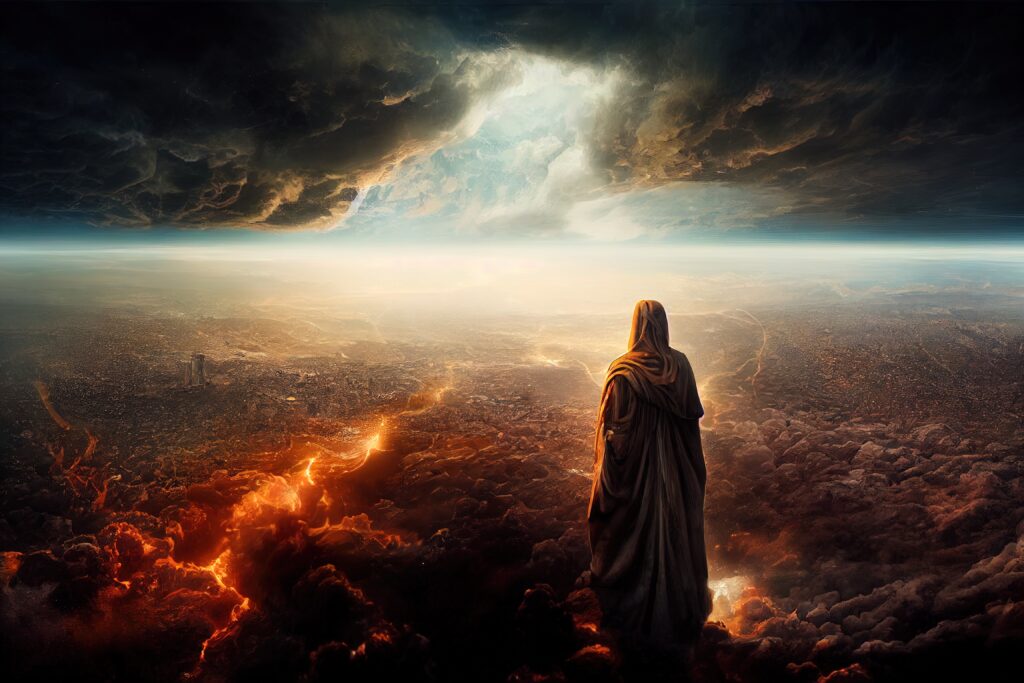
The Meaning of the Trumpets Part 2.
You will recall from our study of the 5th seal that God’s martyred people ( like the blood of martyred Abel in Genesis 4) cried out (metaphorically) from beneath (at the base of) the altar for deliverance and vindication. This is the altar of sacrifice, which in the sanctuary was a symbol of what Christ was to do at the cross. Many, many, many Christians have laid down their lives in honour of what Christ has done for them. They metaphorically cry out for vindication. Well, here it comes!
We now see the results of sin and the ramifications for a world that remains utterly opposed to God, even though He died for it. The whole universe is stunned in awe (the silence in heaven) as it sees the self-destructive force of evil
The devil’s true intentions and character were revealed at the cross. It demonstrated that the devil would if he could, put God himself to death! However, the cross also is a demonstration of the extent God would go to for a fallen world. His character of love and justice was revealed. Subsequently, the devil sought to kill God’s people.
The trumpets demonstrate that they (the opposers of God) only succeed in destroying themselves. Just as the seals revealed the role of the Lamb in salvation and the consequences of that role, so the trumpets sequence reveals what happens when the Lambs power to save is revealed step by step, when God’s glory truly floods a sin-obsessed planet. Watch and wonder!
Consider the Meaning of the Imagery in the first six trumpets. The first trumpet uses the Old Testament language of God’s judgments (hail, fire, and blood [Exod. 9:23–26, Isa. 10:16–20, Ezek. 38:22]) directed against symbols of God’s Old Testament people (vegetation and trees [Ps. 1:1–3; Isa. 61:3; Jer. 11:16, 17]). Hence comes the suggestion that the first trumpet represents God’s judgment on the Jerusalem that had rejected Christ (Matt. 23:37, 38; Luke 23:28–31). The second trumpet recalls, in general, God’s judgments on those who opposed Him (Exod. 7:19–21), and in particular the fall of ancient Babylon (Jer. 51:24, 25, 41, 42). This therefore, would associate this trumpet with the fall of the Roman Empire (compare Peter’s apparent designation of Rome as “Babylon” in 1 Pet. 5:13). The symbolism of the third trumpet parallels biblical imagery for the work of Satan (Isa. 14:12–19, Luke 10:18, Rev. 12:9). But the symbolism of lamp, springs, rivers, and water suggests spiritual life and growth (Ps. 1:3; Ps. 84:6, 7; Ps. 119:105; Jer. 2:13). The falling of the stars and the embittering of the waters connect the two ideas, suggesting a perversion of truth and a rise of apostasy. This associates this trumpet with the condition of the church in the Middle Ages.
In the fourth trumpet, the sources of light (sun, moon, and stars) are darkened, the symbols of truth are partially eclipsed. This darkening represents the deepening of apostasy in the church (Exod. 10:21–23, Job 38:2, Isa. 8:22, John 1:4–11, John 3:18–21). With the fifth trumpet, the partial darkness of the fourth becomes total and worldwide (Rev. 9:1, 2). This represents the triumph of religious apostasy and secularism in the modern age. With God and truth totally eclipsed, sinful humankind is left to the demonic torment of destructive desires (Rev. 9:3–11, Luke 10:17–20). The only safety is in a genuine relationship with God (Rev. 9:4; Eph. 1:13, 14).
While the first five trumpets have many allusions to ancient Egypt, the sixth trumpet particularly echoes biblical accounts regarding ancient Babylon. There are references to the river of Babylon (Rev. 9:14), the idolatry of Babylon (Rev. 9:20; Dan. 5:4, 23), and the fall of Babylon (Rev. 9:21, Isa. 47:9–12). There also are many parallels with the sixth bowl (Euphrates, battle language, demonic imagery [Rev. 16:12–16]). So the sixth trumpet describes an opposition to God similar to that of end time Babylon (Rev. 17:4, 5).
So what is the purpose of the “Interlude” to the Seven Trumpets? The trumpets focus on the wicked (Rev. 9:4, 20, 21), but the “interlude” (Rev. 10:1–11:13) focuses on God’s people. The “interlude,” however, is not separate from the trumpets; it is part of the sixth trumpet. Revelation 8:13 describes three woes coming upon those who live on the earth. The first is the fifth trumpet (Rev. 9:12). The second woe is the sixth trumpet, but it does not end until Revelation 11:14. So the bulk of chapters 10 and 11 are part of the sixth trumpet. While the forces of evil are gathering for the final crisis during the sixth trumpet (Rev. 9:16), the forces of the righteous are gathering to counter them (Rev. 7:4, Rev. 10:1–11:13).

morning Ross when i get home i,m going to study all of the bible verses in today’s lesson God bless you for you taking the time you spend giving us these lessons